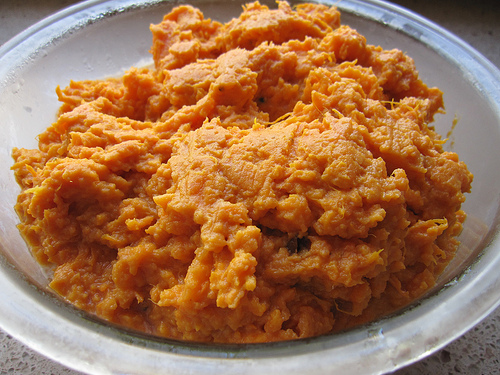
From The New Making of a Cook: The Art, Techniques, And Science Of Good Cooking by Madeleine Kamman.
6 servings
6 large sweet potatoes or yams or 2 large winter squash such as butternut or kabocha
1/4 cup heavy cream, scalded
2 to 3 tablespoons dry sherry or to your personal taste
3 to 8 tablespoons unsalted butter or to your personal taste
Salt
Pepper from the mill
Scalded milk, if and as needed
Bake the sweet potatoes, yams, or squash in a preheated 375 degree to 400 degree Fahrenheit oven until tender, about 1 1/4 hours (or just until very tender in the center). Place the cream in a food processor or blender with the sherry and butter. Scoop put the meat of the vegetables and add to the food processor or blender. Process together until the mixture is smooth and homogeneous. Season with salt and pepper. If too stiff, add a few tablespoons of hot milk as needed. If too soft, reduce over gentle heat until thickened.
(Tip from the Elizabeth Schneider book mentioned below:
For intense sweetness, according to Stanley Kays, “begin in a cold oven, which maximizes the time for hydrolysis of starch and formation of sugar before the enzymes required to produce sugar are denatured.” Increase baking time accordingly.)
__________________________________________________________________________
Orange-fleshed sweet potatoes such as Jewel, Garnet, and the Beauregard (the primary commercial type in the USA), pictured below, are sometimes called “yams” in the USA. These are not true yams. True yams and sweet potatoes are not related. Do not use true yams in this recipe.
Here’s a short discussion from Vegetables from Amaranth to Zucchini: The Essential Reference: 500 Recipes, 275 Photographs
by Elizabeth Schneider:
Orange-fleshed sweet potatoes, however cooked, have a soft, sometimes squishy feel in the mouth and a pumpkin flavor. They are always decidedly sweet, but the degree of sweetness “varies with the cultivar, how they are handled after harvest, and the length of time after harvest. As a consequence, sweetness can be quite variable—and a major frustration for consumers,” says Stanley Kays.
The sweet potatoes preferred outside the United States and Canada are white-fleshed and not usually as sweet or soft as those above—but, like them, they are all highly variable. It is reasonable to generalize about these burly boniato types…. A staple in countries from Mexico to Vietnam, they are more versatile than the orange types, fitting as easily as potatoes into savory meals. Aromatic (freshly cut, they suggest violets), less sweet than our orange varieties, they are fluffier and drier—like a blend of “traditional” sweet potato, chestnut, and a baking potato. They may be rugged and rosy-skinned, or pale and rounded.
__________________________________________________________________
Other kinds discussed in the book:
– Oriental or Japanese or Korean sweet potatoes, which are market catchall terms for various rose-skinned, ivory fleshed cultivars developed in the Far East.
– Pale, moist, soft sweets are generally close to traditionals in texture and sugar but have beige skin and white-to-yellow flesh.

